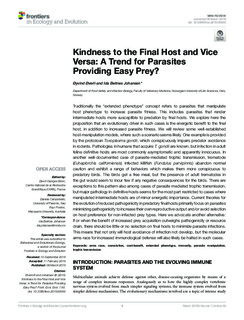| dc.contributor.author | Øverli, Øyvind | |
| dc.contributor.author | Johansen, Ida Beitnes | |
| dc.date.accessioned | 2019-08-12T14:22:45Z | |
| dc.date.available | 2019-08-12T14:22:45Z | |
| dc.date.created | 2019-08-06T08:30:51Z | |
| dc.date.issued | 2019 | |
| dc.identifier.issn | 2296-701X | |
| dc.identifier.uri | http://hdl.handle.net/11250/2607980 | |
| dc.description.abstract | Traditionally the “extended phenotype” concept refers to parasites that manipulate host phenotype to increase parasite fitness. This includes parasites that render intermediate hosts more susceptible to predation by final hosts. We explore here the proposition that an evolutionary driver in such cases is the energetic benefit to the final host, in addition to increased parasite fitness. We will review some well-established host-manipulation models, where such a scenario seems likely. One example is provided by the protozoan Toxoplasma gondii, which conspicuously impairs predator avoidance in rodents. Pathologies in humans that acquire T. gondii are known, but infection in adult feline definitive hosts are most commonly asymptomatic and apparently innocuous. In another well-documented case of parasite-mediated trophic transmission, trematode (Euhaplorchis californiensis) infected killifish (Fundulus parvipinnis) abandon normal caution and exhibit a range of behaviors which makes them more conspicuous to predatory birds. The birds get a free meal, but the presence of adult trematodes in the gut would seem to incur few if any negative consequences for the birds. There are exceptions to this pattern also among cases of parasite mediated trophic transmission, but major pathology in definitive hosts seems for the most part restricted to cases where manipulated intermediate hosts are of minor energetic importance. Current theories for the evolution of reduced pathogenicity in predatory final hosts primarily focus on parasites minimizing pathogenicity to increase their own reproductive output and/or avoid selection on host preference for non-infected prey types. Here we advocate another alternative: If or when the benefit of increased prey acquisition outweighs pathogenicity or resource drain, there should be little or no selection on final hosts to minimize parasite infections. This means that not only will host avoidance of infection not develop, but the molecular arms race for increased immunological defense will also likely be halted in such cases. | nb_NO |
| dc.language.iso | eng | nb_NO |
| dc.rights | Attribution-NonCommercial-NoDerivatives 4.0 Internasjonal | * |
| dc.rights.uri | http://creativecommons.org/licenses/by-nc-nd/4.0/deed.no | * |
| dc.title | Kindness to the final host and vice versa: A trend for parasites providing easy prey? | nb_NO |
| dc.type | Journal article | nb_NO |
| dc.type | Peer reviewed | nb_NO |
| dc.description.version | publishedVersion | nb_NO |
| dc.source.volume | 7 | nb_NO |
| dc.source.journal | Frontiers in Ecology and Evolution | nb_NO |
| dc.source.issue | 50 | nb_NO |
| dc.identifier.doi | 10.3389/fevo.2019.00050 | |
| dc.identifier.cristin | 1714186 | |
| cristin.unitcode | 192,16,2,0 | |
| cristin.unitname | Institutt for mattrygghet og infeksjonsbiologi | |
| cristin.ispublished | true | |
| cristin.fulltext | original | |
| cristin.qualitycode | 1 | |

